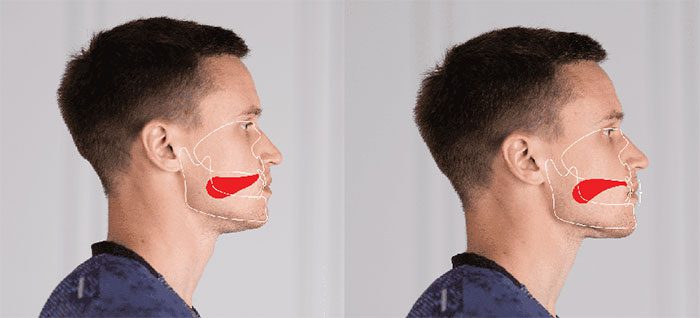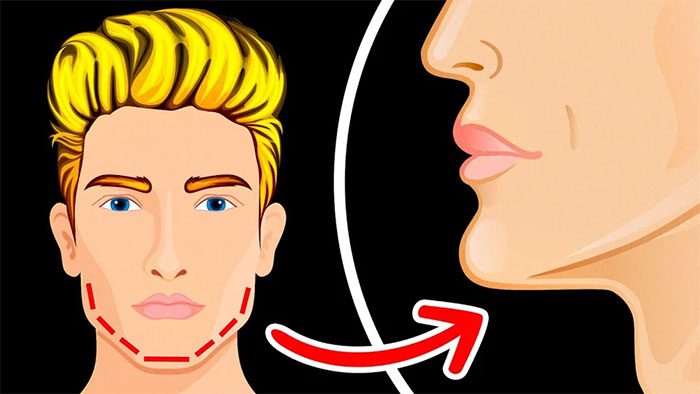The technique of mewing is becoming increasingly popular on social media, with many individuals adopting it in an effort to reshape their faces for a more defined jawline, while also helping to alleviate jaw pain, breathing issues, or orthodontic problems.
However, there is currently no evidence that supports the claims made about this method. Experts also warn that those with jaw issues requiring surgery or orthodontics should not attempt mewing. It is best for individuals to consult with a professional.
1. What You Need to Know About Mewing
Mewing is a facial restructuring technique. It is not a medical term, but rather named after British orthodontist Dr. John Mew, who popularized this method in the 1970s as part of his alternative orthodontic approach known as orthotropics.

Mewing is a technique that uses tongue positioning to shape the jawline and face. (Image: Internet).
2. Benefits of Mewing
Mewing is a technique that some believe can enhance the aesthetics of the jawline. Many individuals adopt this method hoping to improve aesthetic issues such as a broad face, asymmetry, or a flat nose.
Additionally, many claim that this method can address certain issues such as:
Sleep apnea
- Breathing and swallowing problems
- Speech disorders
- Temporomandibular joint dysfunction
- Sinusitis
However, there is no reliable research proving that mewing can permanently alter jaw structure or treat health issues like sinusitis, breathlessness, temporomandibular joint (TMJ) dysfunction, or sleep apnea.
Although not yet recognized by research, mouth posture, or how you position your teeth and tongue, has been shown to affect jaw development in children. A small study involving 50 children indicated that mouth-breathing children exhibited slight changes in facial features.
The American Association of Orthodontists also stated: “The position of the tongue, teeth, and jaw can affect health and appearance, but changes to these structures must occur while a child is still developing or when utilizing advanced methods such as braces or corrective surgery.”
Overall, this method remains highly controversial, and more research is needed to determine the precise effects of mewing on health and aesthetics. If it does have an effect, it will also require a significant amount of time to see results.

Individuals with jaw issues such as misalignment often practice mewing in an attempt to rectify the situation. (Image: Internet)
3. Does Incorrect Mewing Have Effects?
Just as discussions about the benefits of mewing exist, the risks associated with this method are also a topic of debate.
Some argue that this method is unlikely to successfully change the jawline or teeth, thus posing minimal health and aesthetic risks.
Conversely, others believe that overexerting the facial muscles and the temporomandibular joint (TMJ) could lead to side effects such as fatigue, pain, or dysfunction, exacerbating TMJ pain or dysfunction.
If mewing successfully repositions or reshapes the jaw, it could misalign the jaw and teeth. This may contribute to complications such as bite issues, loose or chipped teeth, gum recession, and jaw pain.
4. How to Mew Correctly
To practice mewing, you must relax your tongue and ensure it rests entirely on the roof of your mouth, including the back of the tongue. To make it easier, you can open your mouth, pronounce “N,” and hold your tongue in that position, ensuring it does not touch your teeth. Close your lips and maintain that tongue position for about 20 to 30 minutes.
The correct posture is to stand straight so that your jaw and face are aligned with your chest, whether sitting or standing.
When practicing mewing, consider the following points:
- While practicing the tongue position for mewing, you must still ensure you are breathing evenly through your nose, not your mouth.
- When placing your tongue on the roof of your mouth, do not push against the front teeth, as this action could cause them to protrude.
Initially, you may find it challenging to practice regularly, but with persistence, you will remember how to position your tongue, and it will gradually become your instinctive habit.
Above are answers regarding what mewing is, its benefits, and how to practice. In general, this is not the “miraculous” method that many share. The benefits of this method are not yet clear, so individuals should consult with a doctor before attempting mewing.


















































